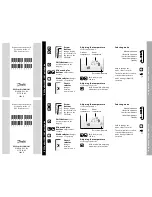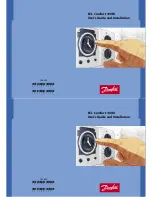
Page 48/82
NEXO
A
NALOGUE
PSTD
C
ONTROLLERS
Title:
symetrical_wiring.eps
Creator:
Adobe Illustrator(R) X
Preview:
This EPS picture was not saved
with a preview included in it.
Comment:
This EPS picture will print to a
PostScript printer, but not to
other types of printers.
CAUTION!
This servicing instruction is for use by qualified service personnel only. To reduce the
risk of electric shock, do not perform any servicing other than that contained in the
operating instructions unless you are qualified to do so.
8.3.5 Recommendations for wiring the sense lines
The impedance of the sense inputs of the TDcontroller are high, so currents are low and therefore light
duty cable can be used. If the TDcontroller is housed in the amplifier racks an unshielded cable may be
used.
If the TDcontroller is located remotely - at the mixing position - a shielded cable is recommended,
without using the shield as a conductor. The cable must be well protected from public access, as it
carries potentially dangerous amplifier voltage.
When one of the channels is not being used and the corresponding sense line is disconnected, cross
talk onto the inactive sense line may in some cases produce signals capable of causing the inadvertent
illumination of the Sense LED on that channel; although this has no effect on the internal operation of
the TDcontroller, it can be cured by short-circuiting the terminals of the inactive sense line.
8.3.6 Recommendations for wiring the audio outputs
The output stages can drive several amplifiers in parallel; however it is not advisable to work with loads
of less than 1kOhm(and strictly forbidden to drive less than 600Ohms
)
. It is best to check the
impedance characteristics of the amplifier inputs - supplied by the manufacturer - to check how many
amplifier channels can be paralleled. Where precise information is not available (and taking 10kOhm as
the minimum value possible), ten channels in parallel per output is a sensible maximum.
8.3.7 Electromagnetic environments
The emission (this word describes all types of electromagnetic noise radiated by the equipment)
requirements whi
ch have been applied to Nexo’s TDcontrollers are the stringent requirements of the
”Commercial and light industrial environment” of the product family EMC standard for emission.
The immunity (this word describes the ability to cope with electromagnetic disturbance generated by
other items and natural phenomena) requirements that we have considered exceed those applicable to
the ”Commercial and light industrial environment” of the product family EMC standard for immunity. In
order to provide a further safety margin, we recommend that you do not operate the TDcontrollers in the
presence of electromagnetic interference exceeding half of the limits found in this standard.
These two EMC standards are those
applicable to pro-audio equipment for the
implementation
of the ”EMC directive”.
8.3.8 Analogue signal cables
Analogue signals should be connected to the
input and output ports of the TDcontroller via
shielded twisted pair or starquad cable fitted
with XLR connectors on the TDcontroller side.
We recommend the use of low transfer
impedance cables with a braided shield and a
transfer impedance below 10 m
Ω/m. For the
sense inputs, the noise requirements are not
as stringent, and any kind of twisted pair cable
will be adequate.
The TDcontroller is intended to be used with
symmetrical (balanced) sources (for instance a mixer) and symmetrical loads (for instance a power
amplifier (see figure). You can see that the TDcontroller provides a low impedance path between pin 1
of its XLR connectors and its chassis. The TDcontroller can sustain high current in pin 1 without
degradation of output noise. We recommend that the sources and loads you use have the same
desirable characteristics.
Summary of Contents for PS Series
Page 17: ...CONNECTION DIAGRAMS Page 17 82 5 CONNECTION DIAGRAMS 5 1 PS8 LS400 with PS8 TDController ...
Page 18: ...Page 18 82 CONNECTION DIAGRAMS 5 2 PS8 LS400 with NXAMP4x1 ...
Page 19: ...CONNECTION DIAGRAMS Page 19 82 5 3 PS8 LS400 with NXAMP4x4 ...
Page 20: ...Page 20 82 CONNECTION DIAGRAMS 5 4 PS10 LS600 with PS10 TDController ...
Page 21: ...CONNECTION DIAGRAMS Page 21 82 5 5 PS10 LS600 with NXAMP4x1 ...
Page 22: ...Page 22 82 CONNECTION DIAGRAMS 5 6 PS10 LS600 with NXAMP4x4 ...
Page 23: ...CONNECTION DIAGRAMS Page 23 82 5 7 PS15 Passive RS15 Omni with PS15 TDController ...
Page 24: ...Page 24 82 CONNECTION DIAGRAMS 5 8 PS15 Passive RS15 Omni with NXAMP4x1 ...
Page 25: ...CONNECTION DIAGRAMS Page 25 82 5 9 PS15 Passive RS15 Omni with NXAMP4x4 ...
Page 26: ...Page 26 82 CONNECTION DIAGRAMS 5 10 PS15 Active with NXAMP4x4 ...
Page 56: ...Page 56 82 TECHNICAL SPECIFICATIONS 9 1 2 Dimensions ...
Page 59: ...TECHNICAL SPECIFICATIONS Page 59 82 9 2 2 Dimensions ...
Page 62: ...Page 62 82 TECHNICAL SPECIFICATIONS 9 3 2 Dimensions ...
Page 66: ...Page 66 82 TECHNICAL SPECIFICATIONS 9 5 2 U Bracket for PS10R2 VNT SSBRK10 Parts Dimensions ...
Page 67: ...TECHNICAL SPECIFICATIONS Page 67 82 9 5 3 U Bracket for PS15R2 VNT SSBRK15 Parts Dimensions ...
Page 73: ...TECHNICAL SPECIFICATIONS Page 73 82 9 6 2 PS10R2 U Bracket VNI UBRK10 Parts Dimensions ...
Page 74: ...Page 74 82 TECHNICAL SPECIFICATIONS 9 6 3 PS15R2 U Bracket VNI UBRK12 Parts Dimensions ...
















































